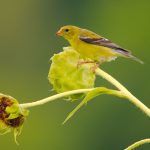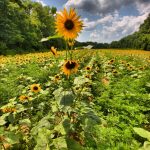A month or two ago I happened to pull out a small Tupperware type container that had cash in it from when I was selling cards and matted photographs. It’s been quite a few years since I did that and at this point, I’m not going to do it any more. There was quite a bit there and I decided I’d use it to buy a telephoto lens, which is something I’ve wanted for quite some time now. I bought a Sigma 150-600mm zoom lens and today was my first outing with it. It’s quite heavy and I had it mounted on a monopod. That isn’t quite as good as a tripod but without that it would have been very difficult to get anything worthwhile. We walked to Blockhouse Point and then drove around to Pennyfield Lock on the C&O Canal. As we were walking back from a nice walk along the canal, I got four photos of this indigo bunting (Passerina cyanea). While it may not an award winning shot, it’s certainly better than anything I’ve been able to get with my other lenses. In the past I’d have to crop quite aggressively to get anything close to this and then it wouldn’t be nearly so sharp. This picture is the full frame. Hopefully there will be more and better bird pictures coming soon.
Tagged With: Passerina cyanea
Indigo Bunting (Passerina cyanea)
McKee-Beshers Sunflowers and Birds
If the Kenilworth Aquatic Gardens are too much of a trek for you but you want flowers and birds, you could do worse than heading out River Road to the McKee-Beshers Wildlife Management Area. Timing your visit is a little difficult because the best time to go varies from year to year and also depends on what it is you want to see. If you just want sunflowers in bloom, then you need to go a little earlier than if you’re mostly interested in seeing birds. The two ‘seasons’ overlap but there will be more birds when the flowers have faded a bit and the seeds are more ripe. For me, I think I hit a pretty happy medium. In field number 1, the flowers were a little past and that’s where I got the pictures here of the indigo bunting (Passerina cyanea) and lots of pictures of American goldfinches (Spinus tristis).
Then, walking further from the parking area to field 4, I found the flowers were in more full bloom. They were all facing to the east and the road to them is to the west. From the road it looked like there were no flowers. But I walked all the way to the far end of the field (about a quarter mile) and back on the other side. It was worth it, as from that side, there were plenty of flowers to be seen. They were much shorter than I’ve seen them in previous years. I’m not sure if that’s a function of the sunflower varieties planted or has more to do with how much rain we get while they are growing.
Rachel Carson Conservation Park
We went to the Rachel Carson Conservation Park today and had a fairly hot and humid walk through the woods. We heard quite a few birds in the woods but saw almost none. We did see these Indian pipe (Monotropa uniflora), also known as ghost plant or ghost pipe. These are parasitic, non-photosynthesizing plants, getting their energy from Russulaceae family of fungi, which in turn get their energy from the roots of photosynthesizing plants. We also saw chanterelle mushrooms (Cantharellus species) and downy rattlesnake plantain (Goodyera pubescens).
Towards the end of our walk we were in the meadows nearer the parking area and I got some photos of the dreaded spotted lanternfly (Lycorma delicatula) in its final nymphal instar stage. There were also indigo buntings (Passerina cyanea) singing all around and I finally found one that I could just see at the top of a tree and got a few photos of that.










